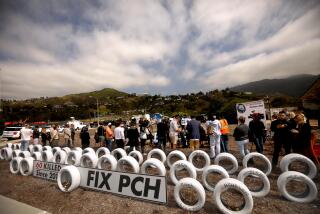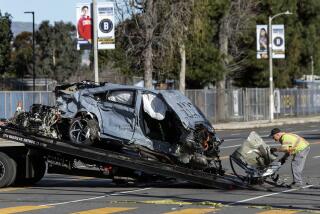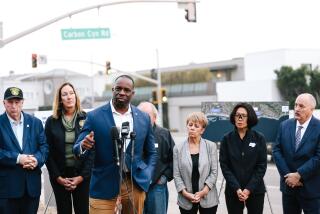‘A Social Problem’ : Parents Buckle Down on Child-Seat Safety
Remember those wonderful old movies and television shows about American family life?
The newborn babe is pink and beautiful and when the time comes to go home from the hospital, daddy helps mommy into the faithful Chevrolet, gently places the blanket-swathed infant in her lap, gets into the car, and they drive off into suburbia.
Beautiful, romantic . . . but terribly wrong, say those who are preoccupied with the fact that auto accidents kill or injure more people than any other mishap--needlessly.
“The new idea is that everyone is buckled up,” said Stephanie Tombrello, executive director of the Inglewood-based Los Angeles Area Child Passenger Safety Assn. This means that mom and dad are wearing seat belts and baby is securely harnessed into a safety seat properly anchored.
“The baby would rather be in your arms,” Tombrello conceded. “That’s a wonderful thing--except in a car.”
Promoting child-seat safety to professional people, parents, schools and community organizations is what Tombrello has been doing since the association was founded six years ago by 15 people--including social workers and health care and child development professionals--who were upset that children were dying unnecessarily.
“We were people who were aware of this as a social problem,” said Tombrello, one of the founders.
And the law is on her side. All children under age 4 or weighing less than 40 pounds must be secured in crash-tested safety seats and all people over age 4 must use regular seat belts. (During the first six months of this year, the California Highway Patrol issued 9,138 citations for violations of the child safety-seat law in the state. Since it began enforcing the new seat belt law on March 1, it has issued 74,267 citations statewide.)
Since 1980, Tombrello said, she has conducted 52 workshops, from Lancaster to Long Beach, and has helped set up numerous car seat loan programs, in which safety-tested seats are made available to parents free or at low cost. Most of the programs are operated by hospitals, but they also include children’s stores, equipment rental agencies and even the Air Force in El Segundo, which makes seats available to military personnel.
Tombrello is about to launch a yearlong program in Redondo Beach, Hermosa Beach and Manhattan Beach with a $12,000 grant from the South Bay Hospital District. Total cost, much of it for personnel time, is $23,000, and the additional money will be provided by Tombrello’s organization.
The child safety association is financed through foundation grants, paid memberships and fund-raising events. It receives free office space from the Los Angeles County Health Services Department.
Determining Needs
Largely educational, the South Bay program will include training of volunteers and professional people in use of safety seats, a community meeting to increase awareness of passenger safety laws and a committee to conduct activities, such as car seat loan programs or preparation of materials on car safety.
“We know there are people out there who care, but they may not know about it,” Tombrello said. “We want to find out the most important needs in the three beach communities in terms of program and then try to come up with priorities.”
Lori Loiacono of Torrance is one South Bay parent who was convinced about the wisdom of safety seats when the first of her three children was born 4 1/2 years ago. In an interview at Riviera Hall preschool in Redondo Beach, she said that auto safety was discussed at a childbirth preparation class she attended, and she bought a safety seat.
“I didn’t leave the hospital without one,” she said, “and we’ve bought them as the children have grown.” She said seats are fitted to the child and shoulder harnesses protect the upper and lower body.
Loiacono recalled two accidents in which her car was struck and she stopped abruptly. “The children were fine. They didn’t go anywhere.”
Phyllis Birch, Riviera Hall director, said her school has a child care safety program but she still sees parents drive away without putting small children into safety seats.
She said the problem really came home to her school two years ago when one of the children flew out of a car, hit his head and was hospitalized. “The accident was not so bad, but it was the child striking his head,” she said.
Virginia D. Fischer, a hospital district board member who serves on the committee that makes recommendations to the full board on grant requests, said the board was impressed with the track record of the association and felt the program would benefit South Bay parents and children.
“Groups would be set up and information would be disseminated to assist in understanding the benefit of using the appropriate child safety measures in an automobile,” she said.
‘Basic Ignorance’
Traffic sergeants in the three beach city police departments said that while they do not see child auto safety as a major problem, the educational program will be a plus. “Generally, the problem with a lot of the people we stop is just one of basic ignorance,” said Hermosa Beach Sgt. John Koebsell.
The association’s first South Bay task, scheduled for this weekend, is observation of safety seat use, or lack of use, that will be conducted by 20 volunteers. Observers will station themselves at exits of shopping center, school and library parking lots and get 500 firsthand reports from each city.
Said Tombrello, “The observations will disclose how many are buckled up properly, incorrectly, or not at all, who is being held in laps, how many are two to a belt, how many have old seats that are non-safe, who has children roaming in the car.”
She said observations in other communities has shown that only two out of five youngsters 15 or younger are correctly buckled.
According to Tombrello, motor vehicle collisions are the No. 1 killer of children and adults up to age 35, the major cause of on-the-job injury and one of the most expensive medical problems in the United States.
“And the thing is,” she added, “it’s all so preventable. . . . The idea is to get all members of a family buckled up for every ride.”
According to the California Highway Patrol, 3,959 people were killed in automobile accidents in California during 1985 and 291,103 were injured. Of those killed, 136 were 15 or younger and there were 20,562 injuries in that age group.
In the three beach cities in 1985, there were no auto accident fatalities involving children under 15. But there were 24 injuries to children in Manhattan Beach 24, 9 in Hermosa Beach and 51 in Redondo Beach.
(The statistics did not differentiate between the use and non-use of seat belts compared to safety seats.)
What is the correct way to use safety seats? Tombrello said that until an infant can sit up well alone, he should ride in the rear of the car facing backward. When he can sit up well alone, usually by the age of 1, he should be placed facing forward. The seat must be securely belted in the car and the child buckled in the seat.
After age 4, she said, a safety booster seat held by a safety belt may be used, or the child may be protected in a shoulder-lap belt as long as it does not cross the face or neck. “You cannot prop a child up on a pillow or book because they fly out on impact,” she said.
Tombrello said that common problems--aside from not using safety seats--are failure to securely fasten the safety seat to the car or the child in the seat. Some people also use non-crash-tested seats. “These are old ones they find in the garage or sometimes in the trash,” she said. “All were manufactured a long time ago and are terrible. They put the child high in the car, a perfect launch position.”
Tombrello said parents fail to use safety seats out of neglect or ignorance.
“People are in a hurry, or they don’t think it matters,” she said. “Lots are new to this country so they are not used to private cars. These people are unaware.”
And there also are those who cannot afford to buy safety seats, which average $45 to $65 but can run considerably higher. This underscores the need for seat loan programs, she said.
Studies bear out Tombrello’s assertions that safety seats, properly used, can be the difference between safety and injury or death.
In the first look at the impact of laws requiring use of child restraint devices, reported in November of 1984, Tennessee researchers said such devices essentially eliminated the risk that children under 4 will be killed in traffic accidents. The study found that child restraint devices were 50% more effective than standard seat belts in preventing injuries to young children and were twice as effective as holding the infant in one’s arms.
The federal National Highway Traffic Safety Administration reported this month that safety seats saved the lives of 158 children in 1985.
More to Read
Sign up for Essential California
The most important California stories and recommendations in your inbox every morning.
You may occasionally receive promotional content from the Los Angeles Times.










